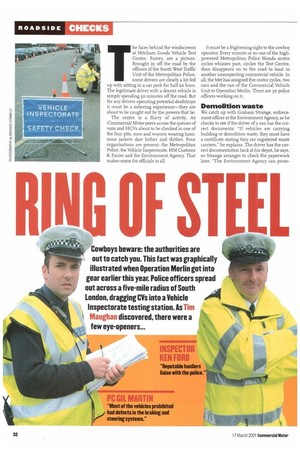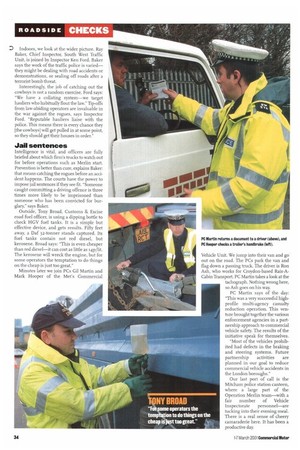STEL
Page 34

Page 35

Page 36

If you've noticed an error in this article please click here to report it so we can fix it.
Cowboys beware: the authorities are out to catch you. This fact was graphically illustrated when Operation Merlin got into gear earlier this year. Police officers spread out across a five-mile radius of South London, dragging CVs into a Vehicle Inspectorate testing station. As
Maughan discovered, there were a
few eye-openers...
The faces behind the windscreens at Mitcham Goods Vehicle Test Centre, Surrey, are a picture. Brought in off the road by the officers of the South West Traffic Unit of the Metropolitan Police, some drivers are clearly a bit fed up with sitting in a car park for half an hour. The legitimate driver with a decent vehicle is simply spending 30 minutes off the road. But for any drivers operating potential deathtraps it must be a sobering experience—they are about to be caught out by the powers that be.
The centre is a flurry of activity. As Commercial Motorpeers across the queues of vans arid HGVs about to be checked in one of the four pits, men and women wearing luminous jackets dart hither and thither. Four organisations are present; the Metropolitan Police, the Vehicle Inspectorate, HM Customs & Excise and the Environment Agency. That makes some Go officials in all.
It must be a frightening sight to the cowboy operator. Every minute or so one of the highpowered Metropolitan Police Honda motor cycles whizzes past, circles the Test Centre, then disappears on to the road to haul in another unsuspecting commercial vehicle. In all, the Met has assigned five motor cycles, two cars and the van of the Commercial Vehicle Unit to Operation Merlin. There are 30 police officers working on it.
Demolition waste
We catch up with Graham Strange, enforcement officer at the Envirorunent Agency, as he checks to see if the driver of a van has the correct documents: If vehicles are carrying building or demolition waste, they must have a certificate stating they are registered waste carriers," he explains. The driver has the correct documentation back at his depot, he says, so Strange arranges to check the paperwork later. The Environment Agency can prose
cute if a haulier does not have the right certificate," warns Strange. "Last time we did so the haulier had to pay a ino fine plus costs."
There are some sorry sights in the pits. A rigid carrying scaffolding has a seriously worn tyre: it looks as if it should be on a Formula One car, not a CV. The vehicle is impounded.
This is the type of defect that galls Dell Evans, a senior traffic examiner at the Vehicle Inspectorate. He says it is the driver's duty to ensure his truck is in perfect working order. "A driver is a professional, and is expected to do a walkabout of his vehicle on a regular basis."
The authorities are there to clamp down on the wrongdoers, but Evans explains that the system is designed to enable the roadworthy trucks to get on their way pronto. He says: The idea of the sifting process is that disruption is kept to a minimum; we will target the older-looking vehicles. We can get a good impression of the condition of a truck just by looking at it. Saying that, an awful lot of traffic that glitters has defects."
To save time and manpower during Operation Merlin, traffic is split into two lanes, laden and unladen. "We get them in and out as soon as possible," says Evans.
Romanian artic
CM spots a stationary Ron.anian artic and curtainsider just a few yards away from the Test Centre. It is not in the queue waiting to be examined: the driver just happened to park there. He could not have picked a worse spot—minutes later he is 'hauled into the pits. Vehicle Examiner Dave Whitcher gets to work, and finds things are not as they should be.
There is a light defect on the trailer, and the loose engine grille swings forward dangerously when the truck grinds to a halt. Whitcher says: "I wouldn't want to be in of front of or behind this vehicle. It is serious enough for a prohibition." And he issues one immediately. Indoors, we look at the wider picture. Ray Baker, Chief Inspector, South West Traffic Unit, is joined by Inspector Ken Ford. Baker says the work of the traffic police is varied— they might be dealing with road accidents or demonstrations, or sealing off roads after a terrorist bomb threat.
Interestingly, the job of catching out the cowboys is not a random exercise. Ford says: "We have a collating system—we target hauliers who habitually flout the law." Tip-offs from law-abiding operators are invaluable in the war against the rogues, says Inspector Ford. "Reputable hauliers liaise with the police. This means there is every chance they [the cowboys] will get pulled in at some point, so they should get their houses in order."
Jail sentences
Intelligence is vital, and officers are fully briefed about which firm's trucks to watch out for before operations such as Merlin start. Prevention is better than cure, explains Baker: that means catching the rogues before an accident happens. The courts have the power to impose jail sentences if they see fit. "Someone caught committing a driving offence is three times more likely to be imprisoned than someone who has been convicted for burglary," says Baker.
Outside, Tony Broad, Customs & Excise road fuel officer, is using a dipping bottle to check HGV fuel tanks. It is a simple but effective device, and gets results. Fifty feet away, a Daf 32-tanner stands captured. Its fuel tanks contain not red diesel, but kerosene. Broad says: "This is even cheaper than red diesel—it can cost as little as r4p/lit. The kerosene will wreck the engine, but for some operators the temptation to do things on the cheap is just too great."
Minutes later we join PCs Gil Martin and Mark Hooper of the Met's Commercial Vehicle Unit. We jump into their van and go out on the road. The PCs park the van and flag down a passing truck. The driver is Ron Ash, who works for Croydon-based Rais-ACabin Transport. PC Martin takes a look at the tachograph. Nothing wrong here, so Ash goes on his way.
PC Martin says of the day: "This was a very successful highprofile multi-agency casualty reduction operation. This venture brought together the various enforcement agencies in a partnership approach to commercial vehicle safety. The results of the initiative speak for themselves.
"Most of the vehicles prohibited had defects in the braking and steering systems. Future partnership activities are planned in our goal to reduce commercial vehicle accidents in the London boroughs."
Our last port of call is the Mitcham police station canteen, where a large part of the Operation Merlin team—with a fair number of Vehicle Inspectorate personnel—are tucking into their evening meal. There is a real sense of cheery camaraderie here. It has been a productive day.
































































































